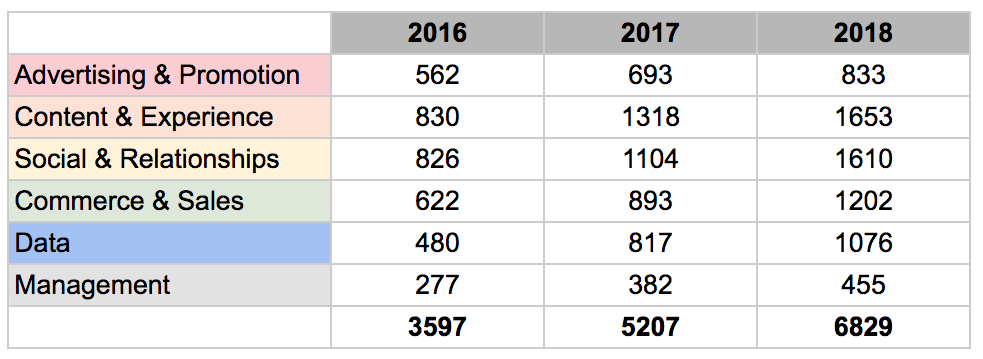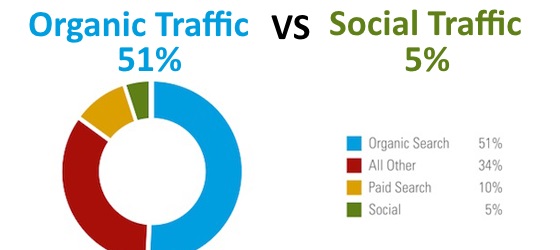Since the turn of the century, artificial intelligence (AI) has been labeled as a game changer for almost every industry, regardless of its size or stature.
From a marketing perspective, AI is a method of leveraging customer data and advanced AI technology (such as machine learning) to anticipate your customer’s next move, and improve their journey.
In fact, the AI-led transformation of the marketing landscape is already underway; consider how social media platforms use AI to present relevant content using machine learning technologies, especially in terms of better product recommendations.
According to Forrester, businesses that invest in AI and nurture a data driven culture will divert $1.2 trillion from businesses that are too slow to catch up to the trend.
AI Has the Ability to Transform the MarTech Landscape
The widespread use of AI has seen it penetrate, and entirely transform, many new areas of business.
AI’s potential touches every facet of the marketing and sales cycle – from supporting marketing and sales efforts at every stage of the buyer’s journey, to automating mundane follow up emails and extracting deeper insights into visitor behavior.

A look into the vast number of MarTech tools reveals that marketers are increasingly turning to sophisticated software-based or SaaS solutions.
In such a competitive and data-driven industry, AI can prove to be the missing link that leads to greater conversions through an optimized marketing process.
Here are some of the biggest MarTech areas that have benefitted from AI:
Product and Content Recommendations
Product and content recommendations have become a staple in brands’ online marketing strategy.
The increasing popularity of e-commerce can be partially attributed to the upselling, cross-selling, and targeted advertisement capabilities afforded by product recommendations.
Also, product recommendations can analyze individual customer behavior and leverage AI to look for patterns and insights, in an attempt to predict future buying behavior.
Such AI-based systems continue to adapt content according to user’s preferences – dishing out recommendations based on a variety of factors. These factors include likes and dislikes paired with profile information, and demographics.
Take Amazon for instance – the e-commerce giant began the use of its now famous algorithm, ‘collaborative filtering’ back in 1998. Fast forward to 2018, and the AI-powered recommendation system is bringing in as much as 35% of the entire revenue amassed by the company.
Besides Amazon, leading digital companies such as Netflix and Spotify have also built their business by providing consumers highly relevant and personalized product recommendations.
The same can be said of social networking platforms that present content on the basis of your preferences.
Search Engines
AI has had a profound impact on how search engines behave and produce a result – and this, in turn, has significantly affected online marketing and advertisement.

Considering that 51% of all website traffic comes from organic search, changes in the search engine experience affects how organizations invest in search engine marketing.
The prime example of how AI affects search engines is the market leader – Google.
Among a plethora of other AI-led initiatives, the software giant launched its AI-powered, machine learning ranking algorithm, RankBrain, in 2015.
The algorithm is a giant leap in how search engines work, as this machine learning based algorithm is capable of continuously learning and evolving its functions over time.
AI has enabled Google’s search engine to process natural language with a heightened accuracy that’s on par, if not greater than humans. This will continue to be a key differentiator for the search engine giant, especially as the world continues to move towards voice-activated controls, home assistants, and voice search.
AI’s impact on search engines doesn’t stop here; modern search engines, powered by AI, can perform a host of other activities, such as semantic searches. Simply put, search engines can now understand user intention and the context of the search query in order to return highly relevant results.
The increased use of AI has allowed search engines to auto-correct grammatical mistakes, determine the links between products, and suggest similar items.
This leads to enhanced user experience; in fact, customers can now discover products they want, even if they don’t know what exactly they are looking for.
Programmatic Advertising
AI has revolutionized conventional advertisement methods – going beyond automating mundane processes by adding a higher degree of precision through advanced data analytics.
One such example is programmatic advertisement, which has automated the process of buying and selling ad inventory through a virtual exchange. In short, this virtual exchange connects advertisers and publishers through a seamless and efficient process.
Additionally, AI has made it possible for marketers to analyze a visitor’s behavior on their website. This means that marketers can optimize their campaigns in real-time, against an audience that is more likely to convert.
Programmatic companies also gather this data to target their audience more precisely. Classic examples of programmatic advertisement include SEM channels, such as Google AdWords, Facebook Ads, and Twitter Ads.
What Does the Future of MarTech Look Like?
The hype surrounding MarTech is nothing new – in fact, MarTech is one of the fastest growing industries, attracting investment of over $14 billion in 2017 alone.

While the present impact of AI in marketing has been positive, there is a certain amount of skepticism regarding the future, which stems from our unfamiliarity with advanced technology.
So, what does the future of AI led marketing look like?
AI and Marketing Will Continue to Revolutionize the Way We Advertise
AI continues to pave the way for marketers to overcome many obstacles – take A/B testing, for instance.
Modern-day marketers are major advocates of A/B testing, having done their fair share of split testing in order to determine what drives the highest traffic, or leads.
Running lengthy tests simultaneously to see what works, comparing the results, and gathering information required to tweak everything further is a relentless pursuit of perfection – safe to say, it’s also a strenuous task.
However, AI has (yet again) provided a much more efficient solution for marketers. Google’s Responsive Search Ads are an AI-powered split testing mechanism, designed to streamline the A/B testing process.
Rather than running multiple headlines and description combinations across different ads campaigns, Google allows you to enter up to 15 headlines and descriptions, in one constantly evolving ad.
Google will continue to present a different combination to users, and highlight the version that works best. Not only does this allow your ads to compete in more auctions, and match more user queries, but it also broadens your potential target audience.
Responsive Search Ads is one of the many developments that AI has afforded in the MarTech arena. According to Gartner, 30% of organizations globally look to integrate AI in at least one of their processes by 2020.
Overall, AI helps marketers understand their consumers better, resulting in a more relevant and optimized buyer journey for consumers. As marketers, our success in the future is reliant on our ability to leverage AI to drive important consumer insights.

Recent Comments